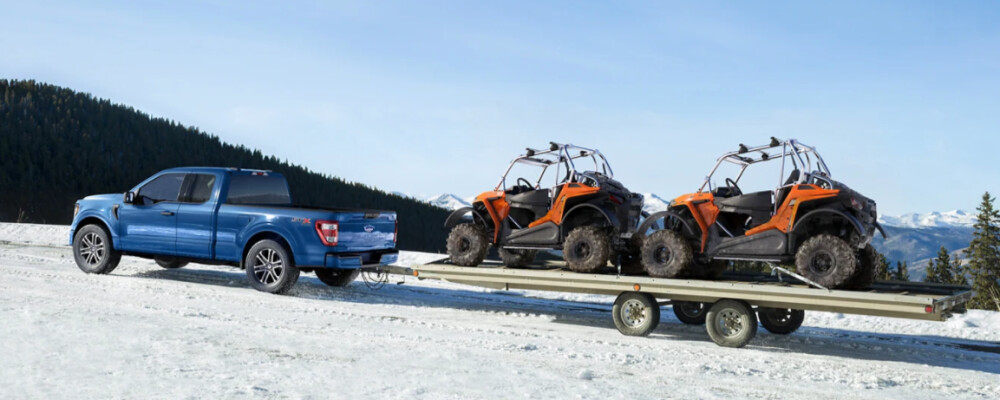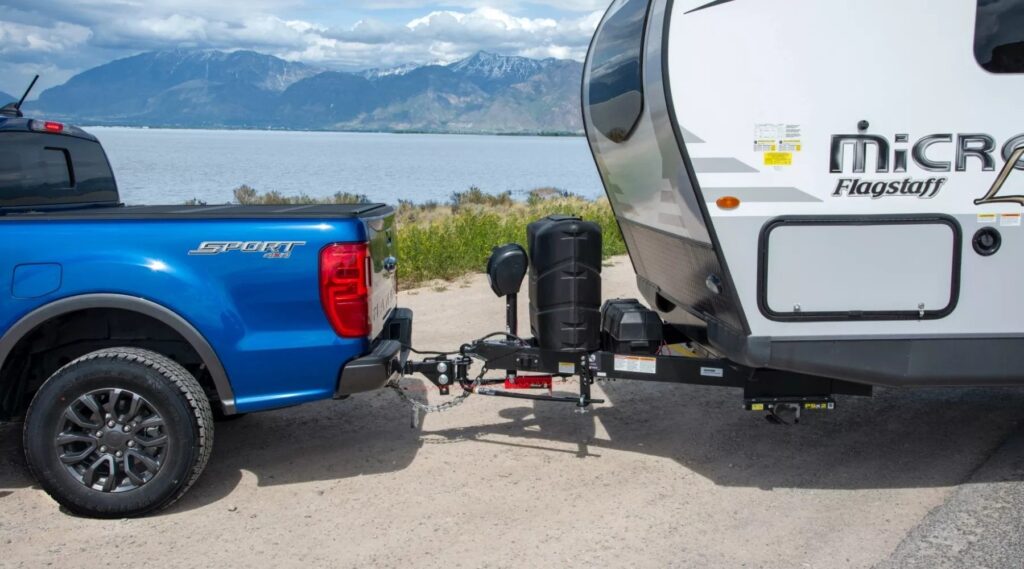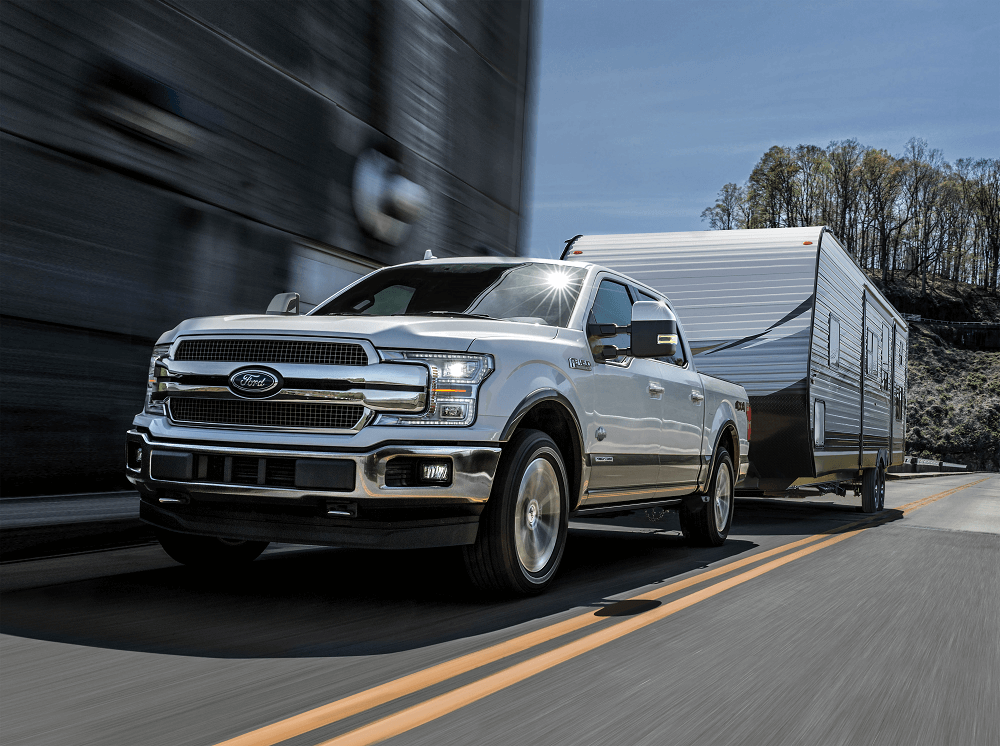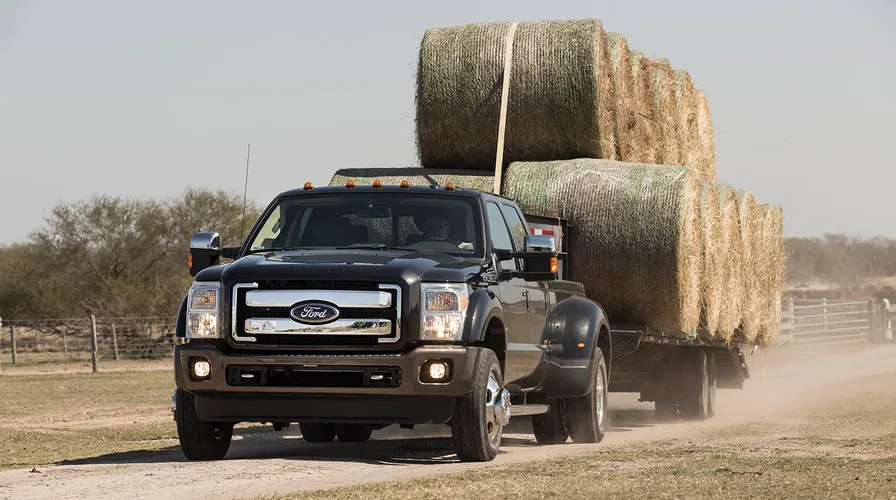The sun was just peeking over the horizon as Sarah hitched her travel trailer to her Ford F-150, ready to embark on a weekend adventure. The excitement of exploring new campsites with her Ford truck towing her home away from home was undeniable. However, as a first-time tower, she couldn’t shake the nerves that came with maneuvering a trailer through traffic and up winding roads. Sarah knew she wasn’t alone. Many Ford truck owners experience similar apprehensions when they first start towing with Ford trucks.
Towing can unlock a whole new world of possibilities, from hauling heavy loads for home projects to embarking on cross-country road trips. Yet, for those who are new to how to tow a trailer with a Ford F-150 or any other Ford truck, the process can seem intimidating. But don’t worry, because it doesn’t have to be.
This comprehensive guide is designed to equip you with everything you need to know about Ford truck towing. We’ll cover everything from understanding your truck’s towing capacity to mastering essential safety tips, ensuring you’re prepared for any towing challenge. By the time you finish reading, you’ll be hitching up your trailer and heading off on your own adventures with the confidence of a seasoned pro.
Understanding Your Ford Truck’s Towing Capacity
Understanding the towing capacity of your Ford truck is essential for safe and efficient hauling. Knowing these limits helps prevent overloading and potential damage to your vehicle. This section explores how to calculate the towing capacity of your Ford truck and the various factors that influence it.
How Much Can My Ford Truck Tow?
This is the million-dollar question for any Ford truck owner looking to hitch up a trailer. But the answer isn’t always straightforward. Your Ford truck’s towing capacity is a complex calculation that depends on several factors, including:
- Truck Model: An F-150 has a different towing capacity than a Super Duty.
- Engine and Drivetrain: A more powerful engine and a higher-end drivetrain will generally have a higher towing capacity.
- Cab and Bed Configuration: Crew cab trucks with shorter beds typically have lower towing capacities than regular cab trucks with longer beds.
- Optional Towing Packages: Certain packages can enhance your truck’s towing capabilities.
To get a precise answer for your specific truck, it’s crucial to understand how to read your Ford truck towing capacity chart.

Decoding the Ford Truck Towing Capacity Chart
Your Ford truck’s owner’s manual and the manufacturer’s website are the best resources to find your specific towing capacity chart. However, deciphering this chart can be a bit like reading a foreign language if you’re not familiar with the terminology. Let’s break down some key terms:
- GVWR (Gross Vehicle Weight Rating): This is the maximum total weight your truck can safely carry, including passengers, cargo, and tongue weight (the downward force exerted on the hitch by the trailer).
- GCWR (Gross Combined Weight Rating): This is the maximum combined weight of your truck and the trailer it’s towing.
- Payload: This is the amount of weight your truck can carry in the cab and bed, not including passengers.
- Tongue Weight: This is the downward force exerted on the hitch by the trailer, typically 10-15% of the trailer’s total weight.
To determine your truck’s maximum towing capacity, you’ll need to consider all these factors. Generally, you can start by finding your truck’s GVWR and GCWR on the chart. Then, subtract your truck’s curb weight (the weight of the truck without any cargo or passengers) from the GVWR to get your available payload. Finally, subtract your payload and the tongue weight of your trailer from the GCWR to get your maximum trailer weight.
Example: 2023 Ford F-150 XLT 4×4 SuperCrew
- GVWR: 7,000 lbs
- GCWR: 13,300 lbs
- Curb Weight: 5,000 lbs
Available Payload: 7,000 lbs – 5,000 lbs = 2,000 lbs
If you have a trailer with a tongue weight of 300 lbs, your maximum trailer weight would be:
13,300 lbs (GCWR) – 5,000 lbs (Curb Weight) – 2,000 lbs (Payload) – 300 lbs (Tongue Weight) = 6,000 lbs
Important Note: Always double-check your calculations and refer to your owner’s manual for specific instructions and safety guidelines before beginning with your ford truck towing journey.
Choosing the Right Hitch and Towing Equipment
Selecting the right hitch and towing equipment is crucial for safe and efficient Ford truck towing journey. Making an informed decision will not only protect your truck but also ensure the safety of yourself and others on the road.
Types of Hitches: Matching the Hitch to Your Needs
There are three main types of hitches used for Ford truck towing:
- Receiver Hitch: The most common type, this hitch slides into a square receiver tube mounted on your truck’s frame. It’s versatile and suitable for various trailers, including boats, campers, and utility trailers. Receiver hitches come in different classes (I-V), with higher classes offering greater towing capacity.
- Fifth-Wheel Hitch: This hitch is installed in the bed of your truck and connects to a special kingpin on the trailer. Fifth-wheel hitches are typically used for large travel trailers and offer superior stability and weight distribution compared to receiver hitches. If you’re planning on towing with Ford trucks and hauling heavy loads, this might be your best bet.
- Gooseneck Hitch: Similar to a fifth-wheel hitch, this type is also installed in the truck bed. However, it uses a ball and coupler connection instead of a kingpin. Gooseneck hitches are commonly used for heavy-duty towing, such as livestock trailers and horse trailers.

The type of hitch you choose depends on your specific needs and the type of trailer you’ll be towing. Consider the weight of your trailer and the towing capacity of your Ford truck when making your decision.
Trailer Brakes and Wiring: Safety First
Properly functioning trailer brakes and electrical connections are non-negotiable when it comes to Ford truck towing safety. Trailer brakes help to control the momentum of the trailer, reducing the strain on your truck’s brakes and improving overall stopping distance.
Ensure your trailer is equipped with brakes that match its weight and that they’re properly adjusted and maintained. Additionally, make sure your trailer’s wiring is in good condition to ensure all lights (brake lights, turn signals, running lights) are working correctly. This is essential for visibility and communication on the road.
Weight Distribution Hitches: Stability and Control
If you’re towing a heavy trailer, a weight distribution hitch (WDH) can be a game-changer. A WDH helps to distribute the weight of the trailer more evenly across the axles of both your truck and the trailer. This improves stability, reduces sway, and enhances overall control while towing with Ford trucks.
WDHs typically use spring bars or torsion bars to transfer weight from the rear of the truck to the front and from the trailer’s tongue to its axles. This helps to level the truck and trailer, improving handling and reducing wear and tear on your truck’s suspension and brakes.
By choosing the right hitch and towing equipment, you’ll be well-equipped to tackle any ford truck towing adventure.
How to Tow a Trailer with a Ford F-150: A Step-by-Step Guide

Towing a trailer with your Ford F-150 can be a smooth and enjoyable experience with the right preparation and technique. Here’s a detailed guide to ensure you’re ready to hit the road:
Prep Your Truck
Before you even think about hitching up your trailer, it’s crucial to make sure your Ford F-150 is ready for the task:
- Tire Pressure: Check the tire pressure in all four tires, including the spare, and adjust to the manufacturer’s recommended pressure for towing (found in your owner’s manual or on the driver’s side door jamb sticker). Properly inflated tires ensure optimal handling and safety when towing with your Ford F-150.
- Fluids: Top off engine oil, coolant, brake fluid, transmission fluid, and power steering fluid if needed. Towing puts extra strain on your truck’s systems, so adequate fluid levels are essential.
- Lights: Test all your truck’s lights – headlights, taillights, brake lights, turn signals, and hazard lights – to ensure they’re working correctly.
- Trailer Brake Controller: If your trailer has brakes, install and properly adjust your trailer brake controller. This device synchronizes your truck’s brakes with the trailer brakes for smoother, more controlled stops.
Hitching the Trailer
Now that your truck is prepped, it’s time to connect the trailer:
- Position: Align your F-150 with the trailer coupler.
- Lower: Lower the coupler onto the hitch ball, ensuring it latches securely.
- Secure: Insert the hitch pin and clip or lock to prevent the coupler from detaching.
- Connect: Attach the safety chains crisscrossed under the tongue of the trailer.
- Wire Up: Connect the trailer’s wiring harness to your truck’s 7-way connector.
- Test: Test the trailer lights (brake lights, turn signals, and running lights) to ensure they’re functioning correctly.
Loading the Trailer
Proper weight distribution is key to safe Ford truck towing:
- 60/40 Rule: Aim to distribute 60% of the trailer’s weight in the front half and 40% in the rear half.
- Tongue Weight: Ensure your tongue weight (the downward force on the hitch ball) is 10-15% of the trailer’s total weight.
- Secure Cargo: Use straps or tie-downs to secure cargo inside the trailer to prevent shifting during transport.
Driving Tips on How to Tow a Trailer with a Ford F-150
Towing a trailer requires adjustments to your usual driving habits:
- Acceleration: Accelerate slowly and smoothly to prevent jerking or swaying.
- Braking: Allow for extra braking distance, and use the manual mode on your transmission to downshift for engine braking when going downhill.
- Turning: Make wider turns to accommodate the trailer’s swing.
- Backing Up: Practice backing up in an empty parking lot before you hit the road.
Mirrors: Use extended towing mirrors for enhanced visibility
Ford Truck Towing Safety Tips
Prioritizing safety is paramount when engaging in Ford truck towing. A few extra precautions can make all the difference in ensuring a smooth and secure journey for you, your passengers, and everyone else on the road.

Pre-Trip Inspection Checklist: Your Safety Net
Before embarking on any ford truck towing adventure, a thorough pre-trip inspection is a must. This checklist ensures everything is in working order and can prevent unexpected breakdowns or accidents:
- Tires: Check tire pressure on both your truck and trailer, ensuring they’re inflated to the correct psi for towing. Visually inspect for any cuts, bulges, or uneven wear.
- Lights: Test all lights on your truck and trailer: headlights, taillights, brake lights, turn signals, hazard lights, and any clearance or marker lights on your trailer.
- Brakes: If your trailer has brakes, test them to ensure they’re engaging properly. If you have a brake controller, confirm it’s calibrated correctly.
- Hitch and Safety Chains: Inspect the hitch connection for tightness and security. Verify the safety chains are crossed under the trailer tongue and properly connected.
- Weight Distribution Hitch (if applicable): If you’re using a weight distribution hitch, double-check the setup and ensure all components are in good condition.
- Coupler and Safety Pin: Make sure the coupler is securely latched onto the hitch ball and the safety pin is in place.
- Cargo: Ensure all cargo is properly secured within the trailer to prevent shifting during transport.
On-the-Road Safety: Vigilance is Key
Safe Ford truck towing extends beyond the initial setup. Once you’re on the road, maintain these practices:
- Safe Distance: Increase your following distance from the vehicle in front of you. A good rule of thumb is to allow one car length for every 10 mph of speed.
- Speed: Reduce your speed, especially in adverse weather conditions or on winding roads. Avoid exceeding the posted speed limit for vehicles towing trailers.
- Weather: Be mindful of weather conditions. Rain, wind, or snow can make towing more challenging. Adjust your speed and driving accordingly.
- Mirrors: Regularly check your mirrors to monitor the position of your trailer and be aware of other vehicles around you.
- Lane Changes: Signal well in advance and change lanes slowly and smoothly.
- Rest Stops: Take breaks every couple of hours to check your truck, trailer, and cargo.
Emergency Procedures: Stay Calm and Take Action
Even with careful planning, emergencies can occur. Here’s what to do if you encounter:
- Trailer Sway: If your trailer starts to sway, don’t slam on the brakes. Instead, gently apply the trailer brakes (if equipped) and gradually reduce your speed. Avoid sudden steering movements.
- Tire Blowout: If a tire blows out, maintain a firm grip on the steering wheel, avoid braking suddenly, and gradually slow down before pulling over to a safe location.
- Overheating: If your truck starts to overheat, pull over as soon as possible, turn off the engine, and let it cool down before inspecting for any issues.
- Brake Failure: If your brakes fail, downshift to a lower gear (if you have a manual transmission) or engage tow/haul mode (if your truck has it). Gradually apply the parking brake to bring your vehicle to a stop.
Maintaining Your Ford Truck for Optimal Towing Performance
When you’re enjoying Ford truck towing, you’re asking a lot of it. Regular maintenance isn’t just a suggestion; it’s a necessity for both longevity and safety. Properly maintaining your truck ensures it can handle the extra stress of towing and keeps you and your cargo safe on the road.
Regular Maintenance: A Long-Term Investment for Ford Truck Towing
While towing with your Ford truck is a rewarding experience, it’s important to remember that it puts increased strain on various components. Here’s why regular maintenance is crucial:
- Engine and Transmission: Towing places extra demand on your engine and transmission. Regular oil changes, filter replacements, and fluid checks ensure these vital systems operate smoothly and efficiently, preventing premature wear and tear when you’re experiencing Ford truck towing.
- Brakes: Towing a heavy trailer requires more braking power, causing your brakes to work harder. Regular brake inspections, pad replacements, and fluid flushes help maintain optimal braking performance and safety, especially crucial for Ford truck towing.
- Suspension: The added weight of a trailer stresses your truck’s suspension. Regular inspections and maintenance of shocks, struts, and other suspension components help maintain a comfortable ride and prevent handling issues during Ford truck towing.
- Cooling System: Towing can increase engine temperature. A well-maintained cooling system, with adequate coolant levels and a properly functioning thermostat, prevents overheating and potential engine damage that could occur while on a Ford truck towing journey.
- Other Components: Don’t neglect regular maintenance of other components, such as the battery, belts, hoses, and lights. These components play an essential role in your truck’s overall performance and safety, especially during your ford truck towing adventure.
By adhering to the manufacturer’s recommended maintenance schedule, you’ll extend the lifespan of your truck and ensure it’s always ready to take on your towing adventures.
Tire Care: The Foundation of Towing Safety
Your tires are the only point of contact between your Ford truck and the road, making them crucial for towing safety and performance when towing with your Ford truck. Here’s what you need to know about tire care when towing:
- Proper Inflation: Ensure your tires are inflated to the correct psi for towing, as specified in your owner’s manual or on the tire placard (usually located on the driver’s side door jamb). Underinflated tires can overheat and fail under the added weight of a trailer.
- Tire Rotation: Regularly rotate your tires to ensure even wear and extend their lifespan. Refer to your owner’s manual for the recommended rotation pattern and schedule.
- Tread Depth: Check your tire tread depth regularly. If it’s below the recommended level, replace your tires to maintain optimal traction and grip while towing with your Ford truck.
- Spare Tire: Make sure your spare tire is in good condition and properly inflated. A flat tire while towing with your Ford truck can be a major inconvenience, so having a reliable spare is essential.
Brake and Transmission Service: Don’t Overlook These Vital Systems
Towing puts extra stress on your Ford truck’s brakes and transmission. Regularly servicing these systems is crucial for safety and performance when you engage with Ford truck towing:
- Brake Service: Have your brakes inspected regularly, especially if you notice any signs of reduced braking performance or unusual noises. Brake pads and rotors may wear down faster when towing, so replace them as needed.
- Transmission Service: Follow the manufacturer’s recommended transmission service intervals. This typically includes fluid changes, filter replacements, and adjustments. Regular transmission service ensures smooth shifting and helps prevent costly repairs.
Advanced Ford Truck Towing Techniques
While basic towing skills are essential, mastering advanced techniques can make a significant difference when faced with challenging conditions. Let’s delve into some tips to elevate your Ford truck towing game.
Towing in Difficult Conditions
Navigating hills, mountains, and inclement weather requires extra caution and specific strategies. Here’s what you need to know:
- Hills and Mountains:
- Downshifting: When descending steep grades, downshift to a lower gear to utilize engine braking and reduce strain on your brakes.
- Tow/Haul Mode: Engage Tow/Haul mode (if your truck has it) to optimize transmission shift points and engine braking.
- Maintaining Speed: Avoid excessive speed when going uphill or downhill.
- Braking: Apply brakes smoothly and gradually when descending. Avoid riding the brakes for extended periods to prevent overheating.
- Inclement Weather:
- Reduced Speed: Decrease your speed significantly in rain, snow, or icy conditions. Wet roads can reduce traction, and snow or ice can make towing extremely hazardous.
- Increased Following Distance: Allow for extra following distance from other vehicles to account for increased stopping distances in slippery conditions.
- Cautious Lane Changes: Make lane changes slowly and gradually, allowing for the trailer’s movement.
- Headlights: Use your headlights even during the day to increase visibility.
Backing Up a Trailer with Confidence
Backing up a trailer can be intimidating for even experienced towers. Here are some advanced maneuvering techniques:
- Slow and Steady: Back up slowly and make small adjustments.
- Steering Wheel Opposite: To move the trailer to the right, turn the steering wheel to the left, and vice versa.
- Watch the Trailer Mirrors: Keep a close eye on your trailer mirrors to monitor the trailer’s position and trajectory.
- Spotter: If possible, have a spotter guide you while backing up.
- Practice: Practice backing up in an empty parking lot until you’re comfortable with the technique.
Using Tow/Haul Mode: Maximizing Performance and Efficiency
If your Ford truck is equipped with Tow/Haul mode, it’s a valuable feature that can optimize your towing experience. Here’s how it works:
- Transmission Shift Points: Tow/Haul mode adjusts the transmission’s shift points, holding gears longer for increased power and torque.
- Engine Braking: It enhances engine braking when descending hills, reducing wear and tear on your brakes.
- Throttle Response: Tow/Haul mode often modifies throttle response for smoother acceleration and improved control.
Conclusion
Mastering the art of Ford truck towing doesn’t have to be overwhelming. With a clear understanding of your truck’s capacity, the right equipment, and a focus on safety, you can confidently haul your boat to the lake, your camper to the mountains, or your work trailer to the job site.
Remember these key takeaways:
- Know Your Limits: Understand your Ford truck’s towing capacity and don’t exceed it.
- Choose the Right Hitch: Match your hitch to your trailer and towing needs.
- Prioritize Safety: Conduct thorough pre-trip inspections and practice safe driving habits.
- Maintain Your Truck: Regular maintenance is essential for optimal towing performance and longevity.
- Master Advanced Techniques: Learn how to handle challenging conditions and maneuvers with confidence.
Ford truck towing can be an incredibly rewarding experience, opening up new possibilities for adventure and utility. So, embrace the journey, plan ahead, and enjoy the freedom that comes with towing!
Do you have any questions or tips to share from your own Ford truck towing adventures? We’d love to hear from you in the comments below!